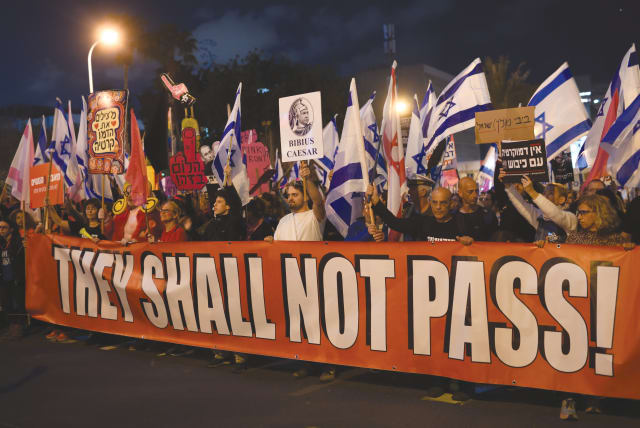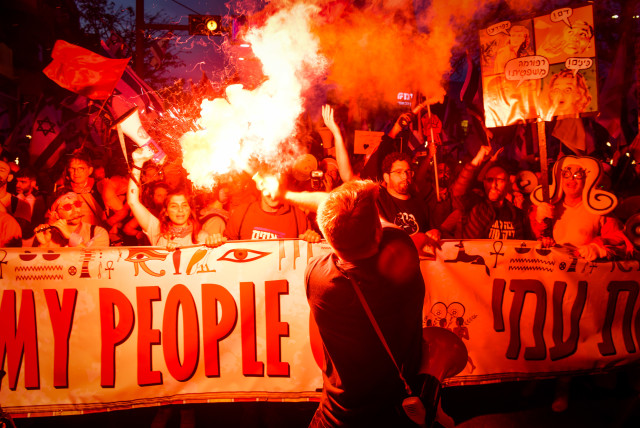Judicial reforms protests are harming Israel - opinion

No one foresaw the determination, tenacity, and ferociousness of the reaction to the government’s program.
On the evening of January 7 this year, several thousand persons marched from Habima to the Tel Aviv Museum Plaza in the first of the weekly demonstrations railing against the judicial reform program presented by Justice Minister Yariv Levin.
They were reacting to Levin’s January 4 appearance at a press conference where he outlined four main areas for legislation: limiting the High Court’s capacity to strike down laws and government decisions; altering the selection process for judges with the government providing more of a say; allowing ministers to appoint their own legal advisers; and doing away with the “reasonableness” instrument that the justices employ – it being purely subjective and political in essence.
Nine months later, Israel is unrecognizable. No one foresaw the determination, tenacity, and ferociousness of the reaction to the government’s program.
Weekly demonstrations were nothing new, of course. Beginning in March 2020, the “Balfour Protest” – in which Shikma Bressler and her brothers Eyal and Yarden Schwartzman initiated convoys to the Knesset to join others who already were outside the Prime Minister’s Residence – took place every week for more than a year.
It was outrageous in noise, costumes, street theater, and the shutting down of main thoroughfares – and completely trampled on the rights of residents of the neighborhood.
Protests throughout the year
Eventually, the Supreme Court intervened but to no real avail. The police recommended that protesters not use drums or other instruments to make loud noise after 9:30 p.m.; and that after 11 p.m., protesters abstain from the use of megaphones, although those restrictions were never consistently applied.
The anti-judicial reform protest, however, unexpectedly turned much more extreme, as Moshe Koppel of the Kohelet Forum admitted in The Wall Street Journal on September 29.
“I didn’t anticipate that they would be willing to use the army as part of the game… [Philanthropist] Arthur Dantchik was hounded for months by protesters in his Philadelphia suburb until he agreed to stop funding the think tank [Kohelet]... In April, opponents also barricaded and vandalized Kohelet’s offices.”
What, then, has the anti-judicial reform protest wrought? In the first instance, it succeeded, for months, in disguising the fact that in essence, plans for the protest had begun prior to Levin’s press conference.
A hard-core group of former Labor Party politicians and Balfour Street graduates met in December 2022 to plan what Ehud Barak had called for two years earlier: a campaign to play on the theme of democracy. The judicial reform was an unexpected gift and the government was accused of fomenting a “regime change.”
Mainstream media and major social platform influencers provided the protest campaign with what Amnon Abramovitz had dubbed the “etrog affect” (back in 2004-5 regarding Ariel Sharon’s protected-by-the-media effort), meaning that it was cushioned and swaddled like the expensive Sukkot holiday fruit in its box The media adopted all the protest vernacular and rhetoric, constantly repeating its messages and drumming its themes into media consumers.
THE CAMPAIGN camouflaged the fact that it had been the Supreme Court itself – notably its former president, Aharon Barak – that had instigated a judicial revolution three decades prior, which at the time was severely criticized by his fellow justices. Many in the political establishment were opposed to elements of what has since developed including many of those who oppose the government today.
Moreover, the etrog effect managed, for several months, to disconnect the protest activities from the background of the trials and charges that Prime Minister Binyamin Netanyahu was facing. It regularized outrageous illegal acts such as blocking main thoroughfares for hours, repeatedly, and yet escaped punishment.
(Similar actions during the 2005 Gaza disengagement had people in jail for weeks and even months.) It sanctified forms of military service refusal and disobedience and endangered Israel’s security by leading both Palestinian Authority terror groups and Iran to assume that Israel was imploding and weak, as a result of a breakdown in societal cohesion.
It made normative the usage of epithets of “Nazi,” “KKK,” “authoritarian dictatorship,” and a slew of additional imprecations, as well as poster images that mirrored far-right antisemitic portrayals of Jews.
It promoted facetious and shallow comparisons with Poland and Hungary’s internal situation while, on the other hand, ignoring the more correct comparisons with many other democratic societies. It also led to the encouragement of emigration, euphemistically called “relocation” to other countries, (the very same ones that they pointed to as illiberal and semi-fascist in order to denigrate the judicial reform).
In practice, the protest supported a policy of no compromise while threatening with voter punishment any opposition politician who sought to reach some sort of agreement. It reached out not only to Diaspora Jewry but to foreign governments, specifically the United States, to strip away any possible support for Israel’s government – and sought to have Israel punished financially.
It has assisted a revival of the worse forms of religious intolerance, with scenes at Tel Aviv’s Dizengoff Square this past Yom Kippur, recalling the activities of the Soviet Yevsektsiya Jewish anti-clerical units.
The protest invaded private property and laid siege to the homes of ministers and members of Knesset, including in the hallways of their apartment buildings. Memorial services were disrupted and military cemeteries became political battlegrounds. Private bereavement was swept aside.
Distressingly, the protest has generated and motivated sub-groups that are exploiting the gatherings and public attention for more divisive aims – such as secularization – which has led to the breaking up of the Yom Kippur prayers in Tel Aviv, attacks on Chabad tefillin stands and the shaming of MK Tzvi Succot’s wife’s hair-covering on X (formerly Twitter).
I am sure the protesters feel they are on a just crusade. What they have wrought, I feel, is not quite right.
The writer is a researcher, analyst, and opinion commentator on political, cultural, and media issues.
Jerusalem Post Store
`; document.getElementById("linkPremium").innerHTML = cont; var divWithLink = document.getElementById("premium-link"); if (divWithLink !== null && divWithLink !== 'undefined') { divWithLink.style.border = "solid 1px #cb0f3e"; divWithLink.style.textAlign = "center"; divWithLink.style.marginBottom = "15px"; divWithLink.style.marginTop = "15px"; divWithLink.style.width = "100%"; divWithLink.style.backgroundColor = "#122952"; divWithLink.style.color = "#ffffff"; divWithLink.style.lineHeight = "1.5"; } } (function (v, i) { });

